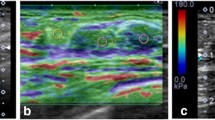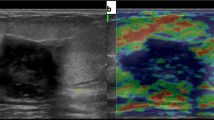Abstract
Purpose
To assess the diagnostic value of strain ratio elastography (SRE), a semiquantitative elastosonographic method based on the displacement of the tissue from an external source (manual compression with the transducer), as compared and in combination with conventional ultrasound for the differentiation of breast lesions.
Methods
One hundred and eighty-two patients with breast lesions consecutively underwent B-mode, color Doppler US, and strain US-elastography. Each lesion was classified according to the BI-RADS lexicon by evaluating the size, the B-mode, and color Doppler features and then evaluated by SRE. Histology proven by biopsy was used as the gold standard and the patients with malignant lesions subsequently underwent operations. The diagnostic performance of each method was assessed with 2 × 2 contingency tables and ROC curve analysis. To maximize the SRE sensitivity and specificity, the SRE cut-off value was calculated using the Youden test.
Results
Histological examination revealed 66 benign and 116 malignant breast lesions. The conventional ultrasound showed sensitivity and specificity for the differentiation of benign and malignant lesions of 86.2% and 75.8%, respectively. Similar results were found for strain US-elastography with a cut-off of 2.49, with sensitivity and specificity of 89.7% and 72.7%, respectively. The association of conventional ultrasound with the SRE value increased the sensitivity (98.3%) but decreased the specificity compared with conventional US alone (63.6%).
Conclusion
Strain US-elastography can be associated with BI-RADS US examination. According to our preliminary results, it helped increase the sensitivity although it decreased the specificity. However, further multicenter studies on a larger population are warranted.




Similar content being viewed by others
Abbreviations
- AUC:
-
Area under curve
- AUROC:
-
Area under the receiver operating characteristic curve
- BI-RADS:
-
Breast imaging, reporting and data system
- EFSUMB:
-
European Federation of Ultrasound in Medicine and Biology
- NPV:
-
Negative predictive value
- PPV:
-
Positive predictive value
- ROC:
-
Receiver operation characteristic
- ROI:
-
Region of interest
- SRE:
-
Strain ratio elastography
- US:
-
Ultrasound
- WFUMB:
-
World Federation of Ultrasound in Medicine and Biology
References
Hooley RJ, Scoutt LM, Philpotts LE (2013) Breast ultrasonography: state of the art. Radiology 268:642–659
Carlino G, Rinaldi P, Giuliani M, Rella R, Bufi E, Padovano F, Ciardi C, Romani M, Belli P, Manfredi R (2019) J Ultrasound 22(1):85–94. https://doi.org/10.1007/s40477-018-0335-0(Epub2018Oct26.Ultrasound-guidedpreoperativelocalizationofbreastlesions:agoodchoice)
Park CS, Lee JH, Yim HW et al (2007) Observer agreement using the ACR Breast Imaging Reporting and Data System (BI-RADS)-ultrasound, First Edition (2003). Korean J Radiol 8(5):397–402
Cosgrove D, Piscaglia F, Bamber J, Bojunga J, Correas JM, Gilja OH, Klauser AS, Sporea I, Calliada F, Cantisani V, D'Onofrio M, Drakonaki EE, Fink M, Friedrich-Rust M, Fromageau J, Havre RF, Jenssen C, Ohlinger R, Săftoiu A, Schaefer F, Dietrich CF (2013) EFSUMB guidelines and recommendations on the clinical use of ultrasound elastography. Part 2: Clinical applications. Ultraschall Med 34(3):238–253
Săftoiu A, Gilja OH, Sidhu PS, Dietrich CF, Cantisani V, Amy D, Bachmann-Nielsen M, Bob F, Bojunga J, Brock M, Calliada F, Clevert DA, Correas JM, D'Onofrio M, Ewertsen C, Farrokh A, Fodor D, Fusaroli P, Havre RF, Hocke M, Ignee A, Jenssen C, Klauser AS, Kollmann C, Radzina M, Ramnarine KV, Sconfienza LM, Solomon C, Sporea I, Ștefănescu H, Tanter M, Vilmann P (2019) The EFSUMB guidelines and recommendations for the clinical practice of elastography in non-hepatic applications: update 2018. Ultraschall Med 40(4):425–453. https://doi.org/10.1055/a-0838-9937(Epub2019Jun25)
Barr RG, Nakashima K, Amy D et al (2015) WFUMB guidelines and recommendations for clinical use of ultrasound elastography: Part 2: breast. Ultrasound Med Biol 41(5):1148–1160
Prado-Costa R, Rebelo J, Monteiro-Barroso J, Preto AS (2018) Ultrasound elastography: compression elastography and shear-wave elastography in the assessment of tendon injury. Insights Imaging 9:791–814
Cantisani V, Bertolotto M, Weskott HP, Romanini L, Grazhdani H, Passamonti M, Drudi FM, Malpassini F, Isidori A, Meloni FM, Calliada F, D’Ambrosio F (2015) Growing indications for CEUS: The kidney, testis, lymph nodes, thyroid, prostate, and small bowel. Eur J Radiol 84(9):1675–1684
Pozza C, Gianfrilli D, Fattorini G et al (2016) Diagnostic value of qualitative and strain ratio elastography in the differential diagnosis of non-palpable testicular lesions. Andrology 4(6):1193–1203. https://doi.org/10.1111/andr.12260
Kamaya A, Machtaler S, Safari Sanjani S, Nikoozadeh A, Graham Sommer F, Pierre Khuri-Yakub BT et al (2013) New technologies in clinical ultrasound. Semin Roentgenol 48:214–223
D’Orsi CJ, Sickles EA, Mendelson EB, Morris EA et al (2013) ACR BI-RADS® Atlas, breast imaging reporting and data system. American College of Radiology, Reston
Mendelson EB, Böhm-Vélez M, Berg WA et al (2013) ACR BI-RADS® Ultrasound. In: ACR BI-RADS® atlas, breast imaging reporting and data system. American College of Radiology, Reston
Ophir J, Cespedes I, Ponnekanti H, Yazdi Y, Li X (1991) Elastography: a quantitative method for imaging the elasticity of biological tissues. Ultrason Imaging 13:111–134
Barr RG, Zhang J et al (2012) Effects of precompression on elasticity imaging of the breast development of a clinically useful semiquantitative method of precompression assessment. Ultrasound Med 31:895–902 (PubMed)
Goksuluk D, Korkmaz S, Zararsiz G et al (2016) easyROC: an interactive web-tool for ROC curve analysis using R language environment. R J 8:213–230
Bartolotta TV, Orlando AAM, Di Vittorio ML et al (2020) S-Detect characterization of focal solid breast lesions: a prospective analysis of inter-reader agreement for US BI-RADS descriptors. J Ultrasound. https://doi.org/10.1007/s40477-020-00476-5
Xiao X, Jiang Q, Wu H, Guan X, Qin W, Luo B (2017) Diagnosis of sub-centimetre breast lesions: combining BI-RADS-US with strain elastography and contrast-enhanced ultrasound—a preliminary study in China. Eur Radiol 27:2443–2450
Suh CH, Choi YJ, Baek JH, Lee JH (2017) The diagnostic performance of shear wave elastography for malignant cervical lymph nodes: a systematic review and meta-analysis. Eur Radiol 27(1):222–230
Cantisani V, Grazhdani H, Ricci P et al (2014) Q-elastosonography of solid thyroid nodules: assessment of diagnostic efficacy and interobserver variability in a large patient cohort. Eur Radiol 24:143–150
Cantisani V, David E, Grazhdani H, Rubini A, Radzina M, Dietrich CF, Durante C, Lamartina L, Grani G, Valeria A, Bosco D, Di Gioia C, Frattaroli FM, D'Andrea V, De Vito C, Fresilli D, D'Ambrosio F, Giacomelli L, Catalano C (2019) Ultraschall Med 40(4):495–503. https://doi.org/10.1055/a-0853-1821[Epub 2019 May 28. Prospective Evaluation of Semiquantitative Strain Ratio and Quantitative 2D Ultrasound Shear Wave Elastography (SWE) in Association with TIRADS Classification for Thyroid Nodule Characterization]
Cantisani V, Grazhdani H, Drakonaki E, D'Andrea V, Di Segni M, Kaleshi E, Calliada F, Catalano C, Redler A, Brunese L, Drudi FM, Fumarola A, Carbotta G, Frattaroli F, Di Leo N, Ciccariello M, Caratozzolo M, D'Ambrosio F (2015) Int J Endocrinol 2015:908575. https://doi.org/10.1155/2015/908575(Epub 2015 Apr 14. Strain US Elastography for the Characterization of Thyroid Nodules: Advantages and Limitation)
Fresilli D, Grani G, De Pascali ML, Alagna G, Tassone E, Ramundo V, Ascoli V, Bosco D, Biffoni M, Bononi M, D'Andrea V, Frattaroli F, Giacomelli L, Solskaya Y, Polti G, Pacini P, Guiban O, Gallo Curcio R, Caratozzolo M, Cantisani V (2020) J Ultrasound 23(2):169–174. https://doi.org/10.1007/s40477-020-00453-y(Epub2020Apr3.Computer-aideddiagnosticsystemforthyroidnodulesonographicevaluationoutperformsthespecificityoflessexperiencedexaminers)
Tan M, Teh HS, Mancer JF, Poh WT (2008) Improving B mode ultrasound evaluation of breast lesions with real-time ultrasound elastography–a clinical approach. Breast 17(3):252–257
Chiorean A, Duma MM, Dudea SM, Iancu A et al (2008) Real-time ultrasound elastography of the breast: state of the art. Med Ultrasonography 10:73–82
Cantisani V, David E, Barr RG et al (2020) US-elastography for breast lesion characterization: prospective comparison of US BIRADS, strain elastography and shear wave elastography [published online ahead of print, 2020 Apr 24]. US-Elastografie zur Charakterisierung von Brustläsionen: Prospektiver Vergleich von US-BI-RADS, Strain-Elastografie und Scherwellen-Elastografie [published online ahead of print, 2020 Apr 24]. Ultraschall Med. https://doi.org/10.1055/a-1134-4937
Nakashima K, Moriya T (2013) Comprehensive ultrasound diagnosis for intraductal spread of primary breast cancer. Breast Cancer 20(1):3–12
Ueno E, Umemoto T, Bando H, Tohno E, Waki K, Matsumura T (2007) New quantitative method in breast elastography: fat lesion ratio (FLR). In: Radiological society of North America 2007 scientific assembly and annual meeting, 25–30 November, Chicago, IL. http://archive.rsna.org/2007/5015476.html
Chen L, He J, Liu G et al (2014) Diagnostic performances of shear-wave elastography for identification of malignant breast lesions: a meta-analysis. Jpn J Radiol 32:592–599
Sadigh G, Carlos RC, Neal CH, Dwamena BA (2012) Accuracy of quantitative ultrasound elastography for differentiation of malignant and benign breast abnormalities: a meta-analysis. Breast Cancer Res Treat 134(3):923–931
Farrokh A, Wojcinski S, Degenhardt F (2011) Diagnostic value of strain ratio measurement in the differentiation of malignant and benign breast lesions. Ultraschall Med 32:400–405 (PubMed)
Alhabshi SM, Rahmat K, Abdul Halim N, Aziz S, Radhika S, Gan GC, Vijayananthan A, Westerhout CJ, Mohd-Shah MN, Jaszle S, Harlina Mohd Latar N, Muhammad R (2013) Semi-quantitative and qualitative assessment of breast ultrasound elastography in differentiating between malignant and benign lesions. Ultrasound Med Biol 39(4):568–578
Funding
This work received no specific funding.
Author information
Authors and Affiliations
Corresponding author
Ethics declarations
Conflict of interest
Federica Pediconi lectured for Bracco, Bayer and Siemens; Vito Cantisani lectured for Bracco, Samsung and Canon. The other authors declare that they have no conflict of interest.
Ethics approval
All procedures performed in studies involving human participants were in accordance with the ethical standards of the institutional and/or national research committee and with the 1975 Helsinki Declaration and its later amendments or comparable ethical standards.
Informed consent
Informed consent was obtained from all individual participants included in the study.
Additional information
Publisher's Note
Springer Nature remains neutral with regard to jurisdictional claims in published maps and institutional affiliations.
Rights and permissions
About this article
Cite this article
Elia, D., Fresilli, D., Pacini, P. et al. Can strain US-elastography with strain ratio (SRE) improve the diagnostic accuracy in the assessment of breast lesions? Preliminary results. J Ultrasound 24, 157–163 (2021). https://doi.org/10.1007/s40477-020-00505-3
Received:
Accepted:
Published:
Issue Date:
DOI: https://doi.org/10.1007/s40477-020-00505-3




